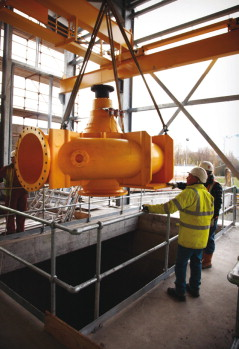
In December 2008, Northern Ireland Water's £100 million Belfast sewers project reached another landmark stage with the delivery of six 15 tonne storm water pumps from Bedford Pumps Ltd, a manufacturer of large, bespoke water and wastewater pumps.
The pumps, which are among the largest in Northern Ireland, are being installed 40 m below ground level at Duncrue Street at the base of the project's terminal pumping station (TPS).
The station itself lies at the end of the 10 km network of new storm tunnels currently under construction below Belfast. The pumps are crucial elements to the whole project, and when operational, will work to alleviate storm conditions and reduce the risk of flooding in the city.
Pump delivered 40 m below ground Level. Each of the six 15 tonne stormwater Belfast sewers project pumps has the capacity to deliver around 3,500 l/s.
Each pump has the capacity to deliver around 3,500 l/s, which means that when all six pumps are installed, together, they could empty an Olympic sized swimming pool in less than two minutes. They are driven by 950 kW, 3.3 kV immersible, flameproof motors.
In addition to the six large storm pumps, the station also includes two smaller FFT pumps which will be used to discharge the lower flows to the treatment works. NI Water had to take the following design consideration into account when selecting the FFT pumps.
• The ability of the pump to maintain a constant flow of 750 l/s over the static head range of 10 m to 36 m while remaining hydraulically stable and operating efficiently.
• Ensure the flowrate within the station pipework was greater than 1.8 m/sec to maintain a self cleansing velocity.
• Minimise the possibility of valve slam by strategic positioning the NRV.
• Construction materials to be capable of withstanding severe abrasion due to the high levels of grit present in the pumpage.
• Need to maintain IP68 degree of protection in the event of flooding.
Brian Henderson, project manager, NI Water welcomed the arrival of the pumps in Belfast; “The arrival of these six storm pumps marks another significant landmark in the project. We have undoubtedly benefited from the expertise of the team at Bedford Pumps.”
Frank Cooper, sales director, Bedford Pumps Ltd, explains how the design specification influenced the selection process: “The arrangement used at this site is a departure from the norm for deep well pumping stations in that traditionally the drive motor is situated at ground floor level thereby ensuring it is kept dry in the event of a flood. The pump is then driven via flexible drive shafting. To support the shafts intermediate plumber type bearings are required at approximately three metre intervals. These bearings in turn require support beams and access for lubrication all of which add to the cost of the installation and present an ongoing maintenance requirement.”
Frank adds; “The alternative is to install dry well submersible pumps. Whilst this overcomes the drive shaft problem the integrity of the pumpset is dependant on the performance of the primary mechanical seal of the pump.
“The solution for NI Water's Belfast sewers project was to use a conventional mixed flow volute pump fitted with a packed gland. This shaft sealing method is tried and tested but also economic to maintain. To protect the motor in the event of a flood Bedford Pumps manufactured an IP68 flameproof machine which was close coupled to the pump. As a result the arrangement minimised the overall cost of the installation whilst ensuring optimum reliability.”
The TPS and tunnel system remain on schedule to become operational in early 2010.




